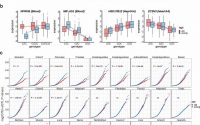Caloric intake and muscle mass at high altitude
New research in The FASEB Journal explored why a group of young, healthy adults residing at high altitude lost muscle mass while severely underfed and consuming the same high-protein diet that preserved muscle during weight loss at sea level.
A team led by Stefan M. Pasiakos, PhD, a nutritional physiologist at the U.S. Army Research Institute of Environmental Medicine, examined eight participants from a larger randomized controlled study. The larger study compared the effects of standard versus high-protein diets on a group of healthy young men hiking at high altitude who experienced increased exercise levels and decreased caloric intake.
Pasiakos and colleagues found that the combination of unaccustomed high-altitude exposure and negative caloric balance resulted in the development of anabolic resistance, or inability to build muscle mass — a phenomenon mainly observed in older adults.
“Findings from our study show that after prolonged exposure to environmental stress and underfeeding, the body’s ability to build and repair muscle was suppressed,” Pasiakos explains. “These data highlight the fundamental relationship between caloric balance and skeletal muscle, and suggest that if efforts to maximize food intake are not prioritized during high-altitude sojourns, muscle mass will be lost.”
The study underscores the importance of maintaining caloric balance at high altitudes, especially among unaccustomed lowlanders. The findings could also have potential implications for individuals with chronic obstructive pulmonary disease (COPD), which decreases oxygen delivery to the body and is often accompanied by both weight loss and lean mass loss.
“Although this study was cast in a high-altitude context, it has revealed unanticipated and potentially broader metabolic complexity that may apply at sea level,” said Thoru Pederson, PhD, Editor-in-Chief of The FASEB Journal. “One cannot resist saying this work takes the subject to a higher level.”
This research was supported, in part, by the U.S. Army Medical Research and Materiel Command.
Source: Read Full Article


